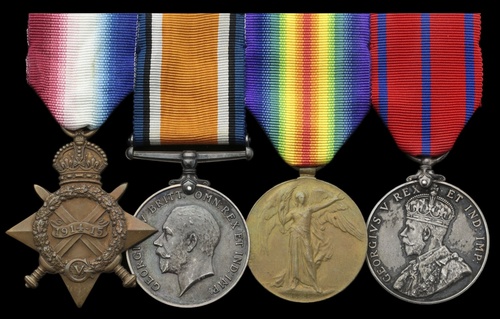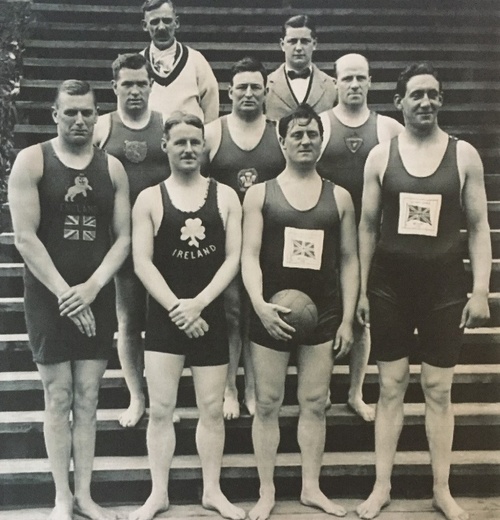Auction: 22003 - Orders, Decorations and Medals
Lot: 418
A notable Great War group of four awarded to Leading Mechanic C. Bugbee, Royal Naval Air Service and City of London Police
A giant for his age - standing at 6ft. 4 inches - he was a double Olympic Gold Medallist in water polo for Great Britain, winning successive golds at the 1912 Stockholm and 1920 Antwerp Olympic Games
But for the intervention of the Great War - in which he was employed in kite balloon ships - he may well have qualified for three successive gold medals, a feat not achieved by a Briton until 1992, when Sir Steve Redgrave memorably won his third rowing award at Barcelona
1914-15 Star (F. 5047 C. Bugnee, A.M.1., R.N.A.S.); British War and Victory Medals (F. 5047 C. Bugbee, L.M., R.N.A.S.); Coronation 1911, City of London Police issue, silver (P.C. C. Bugbee), very fine (4)
Charles Bugbee was born in Stratford, London on 29 August 1887 and served in the City of London Police in the lead-up to the Great War.
Olympic Gold Medallist
He otherwise excelled as a swimmer, taking part in the English Long-Distance Swimming Championship on the River Thames in 1907, before turning his skills to water polo. It was a happy decision for he was selected for the Great Britain's water polo team at the Stockholm Olympic Games in 1912.
Better still, Bugbee and his teammates defeated Belgium and Sweden in round one and the semi-finals, before taking out Austria 8-0 in the final. They were duly awarded Gold Medals.
The Great War intervenes - kite balloons
In May 1915, he enlisted in the Royal Naval Air Service as an Air Mechanic and between July 1915 and March 1917 he was employed in the kite balloon ship H.M.S. Menelaus, the third such vessel ordered by the Admiralty.
Owing to the fact she presented a large target for enemy batteries ashore in Belgium, she undertook an experiment to pass her balloon to a smaller trawler on coming within range of the batteries. The experiment was a success, proving that a balloon could be transferred at sea, even though the balloon plunged badly on transfer and gave the incumbent observers 'an uncomfortable time.'
Between March and June 1917, Bugbee served in the seaplane tender and carrier Campania and, from the latter month until his transferral to the newly established Royal Air Force in April 1918, in the Canning, another kite balloon ship.
His service record also reveals that he was embarked in the hospital ship Garth Castle in May 1918. He was finally transferred to the R.A.F. Reserve in March 1919.
Returning to his duties in the City of London Police, Bugbee was again selected for the Team G.B. water polo squad at the Antwerp Olympics in 1920. Once again, he and his teammates triumphed, taking out the Spanish, American and Belgian teams to collect Gold.
A final outing in the Paris Olympics of 1924 was less successful, Bugbee and his teammates narrowly losing to Hungary 7-6.
Nonetheless, with two Olympic Gold Medals to his name, he featured at No. 34 on a list of the top 150 Team GB Olympians compiled in 2016.
After retiring from the City of London Police, Charles Bugbee was employed as a gatekeeper by the Bank of England. He died in Edgware, Middlesex on 18 October 1959.
Subject to 20% VAT on Buyer’s Premium. For more information please view Terms and Conditions for Buyers.
Estimate
£600 to £700
Starting price
£520







